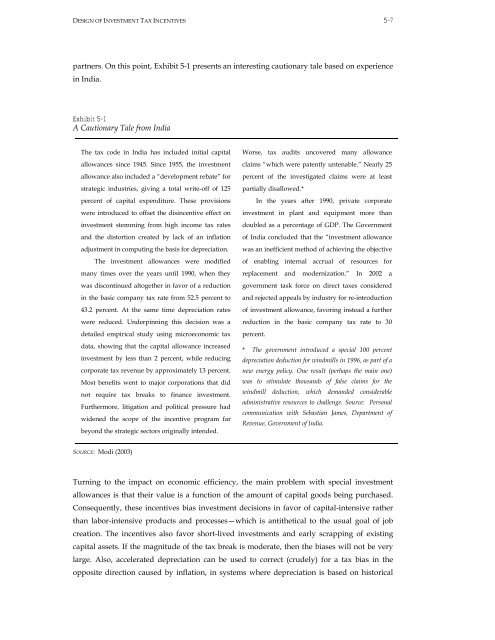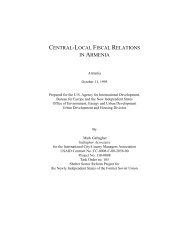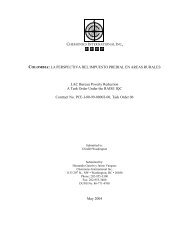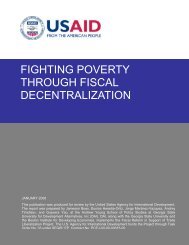Effectiveness and Economic Impact of Tax Incentives in the SADC ...
Effectiveness and Economic Impact of Tax Incentives in the SADC ...
Effectiveness and Economic Impact of Tax Incentives in the SADC ...
You also want an ePaper? Increase the reach of your titles
YUMPU automatically turns print PDFs into web optimized ePapers that Google loves.
DESIGN OF INVESTMENT TAX INCENTIVES 5-7<br />
partners. On this po<strong>in</strong>t, Exhibit 5-1 presents an <strong>in</strong>terest<strong>in</strong>g cautionary tale based on experience<br />
<strong>in</strong> India.<br />
Exhibit 5-1<br />
A Cautionary Tale from India<br />
The tax code <strong>in</strong> India has <strong>in</strong>cluded <strong>in</strong>itial capital<br />
allowances s<strong>in</strong>ce 1945. S<strong>in</strong>ce 1955, <strong>the</strong> <strong>in</strong>vestment<br />
allowance also <strong>in</strong>cluded a “development rebate” for<br />
strategic <strong>in</strong>dustries, giv<strong>in</strong>g a total write-<strong>of</strong>f <strong>of</strong> 125<br />
percent <strong>of</strong> capital expenditure. These provisions<br />
were <strong>in</strong>troduced to <strong>of</strong>fset <strong>the</strong> dis<strong>in</strong>centive effect on<br />
<strong>in</strong>vestment stemm<strong>in</strong>g from high <strong>in</strong>come tax rates<br />
<strong>and</strong> <strong>the</strong> distortion created by lack <strong>of</strong> an <strong>in</strong>flation<br />
adjustment <strong>in</strong> comput<strong>in</strong>g <strong>the</strong> basis for depreciation.<br />
The <strong>in</strong>vestment allowances were modified<br />
many times over <strong>the</strong> years until 1990, when <strong>the</strong>y<br />
was discont<strong>in</strong>ued altoge<strong>the</strong>r <strong>in</strong> favor <strong>of</strong> a reduction<br />
<strong>in</strong> <strong>the</strong> basic company tax rate from 52.5 percent to<br />
43.2 percent. At <strong>the</strong> same time depreciation rates<br />
were reduced. Underp<strong>in</strong>n<strong>in</strong>g this decision was a<br />
detailed empirical study us<strong>in</strong>g microeconomic tax<br />
data, show<strong>in</strong>g that <strong>the</strong> capital allowance <strong>in</strong>creased<br />
<strong>in</strong>vestment by less than 2 percent, while reduc<strong>in</strong>g<br />
corporate tax revenue by approximately 13 percent.<br />
Most benefits went to major corporations that did<br />
not require tax breaks to f<strong>in</strong>ance <strong>in</strong>vestment.<br />
Fur<strong>the</strong>rmore, litigation <strong>and</strong> political pressure had<br />
widened <strong>the</strong> scope <strong>of</strong> <strong>the</strong> <strong>in</strong>centive program far<br />
beyond <strong>the</strong> strategic sectors orig<strong>in</strong>ally <strong>in</strong>tended.<br />
SOURCE: Modi (2003)<br />
Worse, tax audits uncovered many allowance<br />
claims “which were patently untenable.” Nearly 25<br />
percent <strong>of</strong> <strong>the</strong> <strong>in</strong>vestigated claims were at least<br />
partially disallowed.*<br />
In <strong>the</strong> years after 1990, private corporate<br />
<strong>in</strong>vestment <strong>in</strong> plant <strong>and</strong> equipment more than<br />
doubled as a percentage <strong>of</strong> GDP. The Government<br />
<strong>of</strong> India concluded that <strong>the</strong> “<strong>in</strong>vestment allowance<br />
was an <strong>in</strong>efficient method <strong>of</strong> achiev<strong>in</strong>g <strong>the</strong> objective<br />
<strong>of</strong> enabl<strong>in</strong>g <strong>in</strong>ternal accrual <strong>of</strong> resources for<br />
replacement <strong>and</strong> modernization.” In 2002 a<br />
government task force on direct taxes considered<br />
<strong>and</strong> rejected appeals by <strong>in</strong>dustry for re-<strong>in</strong>troduction<br />
<strong>of</strong> <strong>in</strong>vestment allowance, favor<strong>in</strong>g <strong>in</strong>stead a fur<strong>the</strong>r<br />
reduction <strong>in</strong> <strong>the</strong> basic company tax rate to 30<br />
percent.<br />
* The government <strong>in</strong>troduced a special 100 percent<br />
depreciation deduction for w<strong>in</strong>dmills <strong>in</strong> 1996, as part <strong>of</strong> a<br />
new energy policy. One result (perhaps <strong>the</strong> ma<strong>in</strong> one)<br />
was to stimulate thous<strong>and</strong>s <strong>of</strong> false claims for <strong>the</strong><br />
w<strong>in</strong>dmill deduction, which dem<strong>and</strong>ed considerable<br />
adm<strong>in</strong>istrative resources to challenge. Source: Personal<br />
communication with Sebastian James, Department <strong>of</strong><br />
Revenue, Government <strong>of</strong> India.<br />
Turn<strong>in</strong>g to <strong>the</strong> impact on economic efficiency, <strong>the</strong> ma<strong>in</strong> problem with special <strong>in</strong>vestment<br />
allowances is that <strong>the</strong>ir value is a function <strong>of</strong> <strong>the</strong> amount <strong>of</strong> capital goods be<strong>in</strong>g purchased.<br />
Consequently, <strong>the</strong>se <strong>in</strong>centives bias <strong>in</strong>vestment decisions <strong>in</strong> favor <strong>of</strong> capital-<strong>in</strong>tensive ra<strong>the</strong>r<br />
than labor-<strong>in</strong>tensive products <strong>and</strong> processes—which is anti<strong>the</strong>tical to <strong>the</strong> usual goal <strong>of</strong> job<br />
creation. The <strong>in</strong>centives also favor short-lived <strong>in</strong>vestments <strong>and</strong> early scrapp<strong>in</strong>g <strong>of</strong> exist<strong>in</strong>g<br />
capital assets. If <strong>the</strong> magnitude <strong>of</strong> <strong>the</strong> tax break is moderate, <strong>the</strong>n <strong>the</strong> biases will not be very<br />
large. Also, accelerated depreciation can be used to correct (crudely) for a tax bias <strong>in</strong> <strong>the</strong><br />
opposite direction caused by <strong>in</strong>flation, <strong>in</strong> systems where depreciation is based on historical











